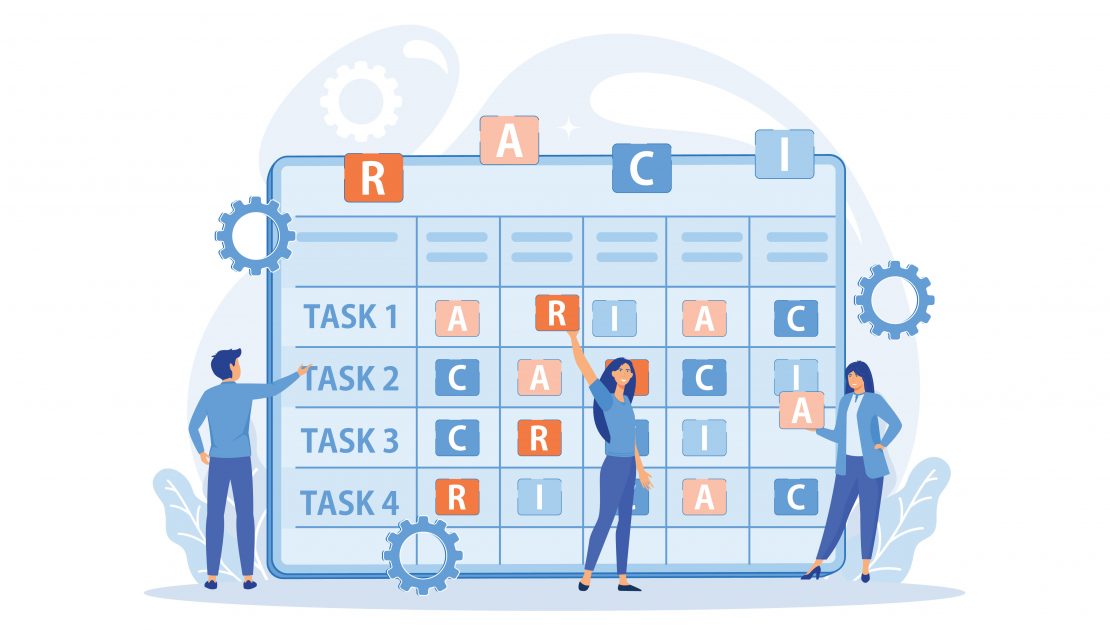
- May 23, 2023
- Ela Stilwell
- Podcast
- No Comments
Clarity in roles and responsibilities is vital to the success of any project. When people are unclear on what they’re supposed to be doing, it creates confusion, frustration, and sometimes resentment. Rod and Dale break down the RACI chart, which helps map out who’s responsible, accountable, consulted and informed.
Our blog posts are a condensed version of our podcast! Listen to the episode linked above to hear Rod and Dale take you through this content.
A lack of clarity can show up in many ways. It can result in people not knowing who’s doing what or assuming who’s in what role. Another result is multiple people thinking they have the same role, leading to a lot of toe-stepping, avoidable conflict, and wasted time. These gaps in clarity can lead to important things falling through the cracks and issues in your project.
We need to be intentional, to actually sit down and consider who is responsible, accountable and consulted. Then, ask who the stakeholders are that need to be informed.
Responsible or Accountable?
Responsibility and accountability are two areas that often get confused in the RACI chart.
Traditionally, someone who is responsible is actually doing the work. They get the results required for the given action. The accountable person is the person who ultimately will be judged on whether or not it happens. Often, that has some form of hierarchy or order to it.
The communication specialist is responsible for getting the communication out there, ensuring it’s accurate and following all the standards. But the project manager is accountable to the stakeholders for ensuring that the communication happens.
Just because you’re hierarchically superior, that doesn’t automatically make you the accountable person. It’s essential to look at each task and ask ourselves how we can drive this down to the right level to be then able to get the results. We have to drive down to the lowest level possible to hold individuals accountable for the things over which they have authority.
An area of overlap is motivation. By motivation, we mean, does the person even want the responsibility or accountability? Did they draw the short straw and now have to do it? This is a question of getting them engaged, excited, and passionate.
You can also have an accountability partner as a de-blocker who helps get stuff out of the way so the person responsible can make it happen.
Responsible
Prime Minister Margaret Thatcher noted that the leader’s responsibility is to create the vision. They can’t be responsible for everything that happens in the present, but they can create a vision of the future and then move things out of the way so people can achieve that vision.
When you’re looking at who’s responsible for a task, some of the types of questions you need to ask yourself are:
- Does this person have the skills necessary to do the work?
- Does this person have the time to do the work?
- Are they equipped to do the work?
- Do they have the competency?
- Do they have the motivation?
- Have they had the path cleared so that they can do that work?
On a well-functioning project team, you hope that everybody on the project feels responsible for the success of the project. However, the project manager must be responsible for the project’s success.
Harkening back to our conversation on trust, you need to feel confident that others will do the things they are responsible for. But if it’s unclear who’s responsible, trust can be eroded for the wrong reasons.
Accountable
You can’t make someone accountable for something they have no control over. You can put their name down, but there’s no way you’ll ever be able to hold them accountable for that. And you can’t make someone responsible for work they can’t accomplish for lack of time or skill.
When you’re looking at who’s accountable, consider:
- Is this the person who can move the roadblocks?
- Is this the person who has the approval, the ability to approve certain things that need to happen?
- Is this person motivated?
It comes down to the clarity that allows us to focus not on pointing fingers but on developing and growing people, so they can do the job we expect them to do. Holding people accountable is always a challenge, so if it’s unclear, it’s easy for nobody to own the accountability.
Consult
Clarity about who needs to be consulted also helps avoid ruffling feathers when a consultation doesn’t occur. The benefit of consulting the right people before making a decision is a better decision.
Often when we start projects, there’s feasibility and pre-feasibility dialogue where we establish almost unspoken communication patterns. As the project grows, some early communication patterns stay with us, even if who needs to be consulted or informed may change.
Rod: I’ve also discovered that very few people have the rigour to identify those who need to be consulted and are pretty quick to backpedal when they discover that they didn’t talk to the right people. We see that when the right people weren’t at the right meeting, that often means the decisions made weren’t the best.
Consulting requires being open enough to seek the expertise valuable for the project from those who can’t be assigned to this project. You have to push past the assumption that you don’t need those people and can do it all yourself or that you have all the necessary knowledge.
Consulting also requires facing the discomfort of conflicting perspectives to pursue the best project outcome. Our egos often result in us surrounding ourselves with people we agree with. You want diversity of viewpoint, background, and opinion. For more insight into how to do this, look at our podcast on tough conversations.
Remember that consultation does not shift responsibility or accountability. Someone with the expertise required to accomplish the job should be held accountable, not simply consulted.
Inform
The stakeholders who need to be informed must be identified at the outset. This is the easiest to overlook, as we assume they’ll find out somehow. Whether it’s a spouse or a boss, being intentional about informing the parties impacted is essential.
Consider the “when” of informing, as people may raise important issues that require a pivot. Each project should have a communication plan with times for regular communications of major milestones or work. Keeping people informed helps move the project forward, reducing the need to backtrack.
A general rule that overrides the informing schedule is when things go wrong. Always deliver bad news as soon as you know. Inform those necessary of the problem and your planned solution. Regardless of how uncomfortable the conversation is, knowing who needs to be informed can make it easier to enter that conversation.
Consult or Inform?
Rod and Dale identify that consulting occurs with people with valuable data, input, information or insights required for successful task completion. It’s in everyone’s best interest to get that information. Informing is more of an outward communication, a checkpoint ensuring the person has the right information for their actions. Here, you’re not looking for feedback – the key distinction from consulting.
The RACI model is not primarily about the process. It’s about helping people deliver their best because they are clear on who’s responsible for what they understand where the accountability lies; they are getting feedback information or consultation from the right group of people.
Our recommendation? Be intentional and deliberate about making choices.
